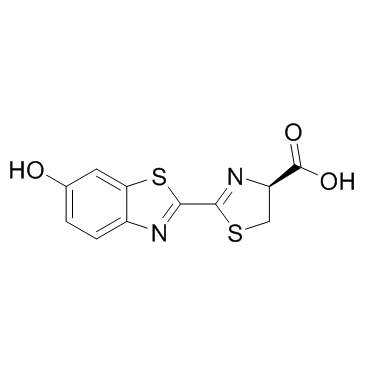D-(-)-荧光素

D-(-)-荧光素结构式

|
常用名 | D-(-)-荧光素 | 英文名 | D-Luciferin |
|---|---|---|---|---|
| CAS号 | 2591-17-5 | 分子量 | 280.323 | |
| 密度 | 1.8±0.1 g/cm3 | 沸点 | 587.6±60.0 °C at 760 mmHg | |
| 分子式 | C11H8N2O3S2 | 熔点 | 200-204ºC | |
| MSDS | 中文版 美版 | 闪点 | 309.2±32.9 °C |
|
PSMA-specific CAR-engineered T cells eradicate disseminated prostate cancer in preclinical models.
PLoS ONE 9(10) , e109427, (2014) Immunology-based interventions have been proposed as a promising curative chance to effectively attack postoperative minimal residual disease and distant metastatic localizations of prostate tumors. We developed a chimeric antigen receptor (CAR) construct tar... |
|
|
Minimizing the non-specific binding of nanoparticles to the brain enables active targeting of Fn14-positive glioblastoma cells.
Biomaterials 42 , 42-51, (2014) A major limitation in the treatment of glioblastoma (GBM), the most common and deadly primary brain cancer, is delivery of therapeutics to invading tumor cells outside of the area that is safe for surgical removal. A promising way to target invading GBM cells... |
|
|
Loss of CX3CR1 increases accumulation of inflammatory monocytes and promotes gliomagenesis.
Oncotarget 6 , 15077-94, (2015) The most abundant populations of non-neoplastic cells in the glioblastoma (GBM) microenvironment are resident microglia, macrophages and infiltrating monocytes from the blood circulation. The mechanisms by which monocytes infiltrate into GBM, their fate follo... |
|
|
Immunomodulatory effects of Lippia sidoides extract: induction of IL-10 through cAMP and p38 MAPK-dependent mechanisms.
J. Med. Food 18(3) , 370-7, (2015) Lippia sidoides is an aromatic shrub that grows wild in the northeastern region of Brazil. In local traditional medicine, the aerial portions of this species are used as anti-infectives, antiseptics, spasmolytics, sedatives, hypotensives, and anti-inflammator... |
|
|
Inhibitors of the 5-lipoxygenase arachidonic acid pathway induce ATP release and ATP-dependent organic cation transport in macrophages
Biochim. Biophys. Acta 1838(7) , 1967-77, (2014) We have previously described that arachidonic acid (AA)-5-lipoxygenase (5-LO) metabolism inhibitors such as NDGA and MK886, inhibit cell death by apoptosis, but not by necrosis, induced by extracellular ATP (ATPe) binding to P2X7 receptors in macrophages. ATP... |
|
|
Selective antitumor effect of neural stem cells expressing cytosine deaminase and interferon-beta against ductal breast cancer cells in cellular and xenograft models.
Stem Cell Res. 12(1) , 36-48, (2014) Due to their inherent tumor-tropic properties, genetically engineered stem cells may be advantageous for gene therapy treatment of various human cancers, including brain, liver, ovarian, and prostate malignancies. In this study, we employed human neural stem ... |
|
|
A novel combinational approach of microstimulation and bioluminescence imaging to study the mechanisms of action of cerebral electrical stimulation in mice.
J. Physiol. 593 , 2257-78, (2015) Deep brain stimulation (DBS) is used to treat a number of neurological conditions and is currently being tested to intervene in neuropsychiatric conditions. However, a better understanding of how it works would ensure that side effects could be minimized and ... |
|
|
Third-party CD4+ invariant natural killer T cells protect from murine GVHD lethality.
Blood 125 , 3491-500, (2015) Graft-versus-host disease (GVHD) is driven by extensive activation and proliferation of alloreactive donor T cells causing significant morbidity and mortality following allogeneic hematopoietic cell transplantation (HCT). Invariant natural killer T (iNKT) cel... |
|
|
Differential potency of regulatory T cell-mediated immunosuppression in kidney tumors compared to subcutaneous tumors.
Oncoimmunology 3(11) , e963395, (2015) In many cancers, regulatory T cells (Treg) play a crucial role in suppressing the effector immune response thereby permitting tumor development. Indeed, in mouse models, their depletion can promote the regression of tumors of various origins, including renal ... |
|
|
SPARC mediates metastatic cooperation between CSC and non-CSC prostate cancer cell subpopulations.
Mol. Cancer 13 , 237, (2014) Tumor cell subpopulations can either compete with each other for nutrients and physical space within the tumor niche, or co-operate for enhanced survival, or replicative or metastatic capacities. Recently, we have described co-operative interactions between t... |